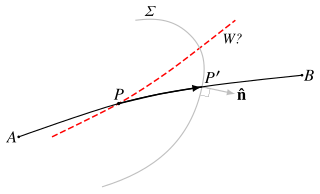
Back مبدأ فيرما Arabic Прынцып Ферма Byelorussian Принцип на Ферма Bulgarian Principi de Fermat Catalan Fermatův princip Czech Fermats princip Danish Fermatsches Prinzip German Αρχή του ελαχίστου χρόνου Greek Principio de Fermat Spanish Fermat' printsiip Estonian

Fermat's principle, also known as the principle of least time, is the link between ray optics and wave optics. Fermat's principle states that the path taken by a ray between two given points is the path that can be traveled in the least time.
First proposed by the French mathematician Pierre de Fermat in 1662, as a means of explaining the ordinary law of refraction of light (Fig. 1), Fermat's principle was initially controversial because it seemed to ascribe knowledge and intent to nature. Not until the 19th century was it understood that nature's ability to test alternative paths is merely a fundamental property of waves.[1] If points A and B are given, a wavefront expanding from A sweeps all possible ray paths radiating from A, whether they pass through B or not. If the wavefront reaches point B, it sweeps not only the ray path(s) from A to B, but also an infinitude of nearby paths with the same endpoints. Fermat's principle describes any ray that happens to reach point B; there is no implication that the ray "knew" the quickest path or "intended" to take that path.

In its original "strong" form,[2] Fermat's principle states that the path taken by a ray between two given points is the path that can be traveled in the least time. In order to be true in all cases, this statement must be weakened by replacing the "least" time with a time that is "stationary" with respect to variations of the path – so that a deviation in the path causes, at most, a second-order change in the traversal time. To put it loosely, a ray path is surrounded by close paths that can be traversed in very close times. It can be shown that this technical definition corresponds to more intuitive notions of a ray, such as a line of sight or the path of a narrow beam.
For the purpose of comparing traversal times, the time from one point to the next nominated point is taken as if the first point were a point-source.[3] Without this condition, the traversal time would be ambiguous; for example, if the propagation time from P to P′ were reckoned from an arbitrary wavefront W containing P (Fig. 2), that time could be made arbitrarily small by suitably angling the wavefront.
Treating a point on the path as a source is the minimum requirement of Huygens' principle, and is part of the explanation of Fermat's principle. But it can also be shown that the geometric construction by which Huygens tried to apply his own principle (as distinct from the principle itself) is simply an invocation of Fermat's principle.[4] Hence all the conclusions that Huygens drew from that construction – including, without limitation, the laws of rectilinear propagation of light, ordinary reflection, ordinary refraction, and the extraordinary refraction of "Iceland crystal" (calcite) – are also consequences of Fermat's principle.
- ^ Cf. Young, 1809, p. 342; Fresnel, 1827, tr. Hobson, pp. 294–6, 310–11; De Witte, 1959, p. 293n.
- ^ Cf. Born & Wolf, 2002, p. 876.
- ^ De Witte (1959) invokes the point-source condition at the outset (p. 294, col. 1).
- ^ De Witte (1959) gives a proof based on calculus of variations. The present article offers a simpler explanation.